There is an inherent complexity to Facebook ads that can leave many advertisers feeling overwhelmed or at least worried that they are not checking all of the right boxes when it comes to proper management.

However, managing a Facebook ad account doesn’t have to be overly complex and there are many principles that, if you make them habit, will make life easier for you in the long run. Whether you are managing a Facebook ad account that has a long history or simply starting from scratch, these same basic rules apply. In this post I will walk you through some of my basic principles of managing a Facebook ad account.
7 habits of highly effective Facebook advertisers
The difference between folks who tell you Facebook advertising works and those who say it doesn’t can often come down to these seven fundamentals.
1. They organize campaigns by objective, not audience
Let’s start at the highest level: the account as a whole. Facebook ad account structure is incredibly important for its long-term health, reporting visibility, and ease of optimization. The simplest way to plan an efficient account structure is by thinking through the three elements that comprise a campaign:
If you properly plan how you want your campaigns organized, everything else should fall into place. One of the biggest mistakes I see Facebook advertisers make is confusing the purpose of the campaign level with that of the ad set level. Campaigns should always be focused on the central goal: specific conversions, web traffic, video views, etc.
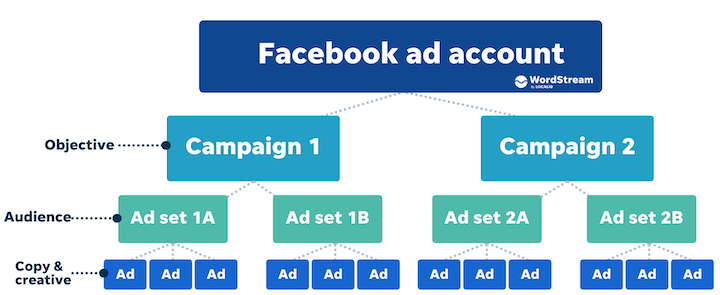
But all too often, I see folks naming/organizing their campaigns by particular audience. For example:
Example #1:
- Campaign: Restaurants
- Ad Set: Restaurant (multiple restaurant audiences in one)
- Ads: (mix of restaurant promotions)
Example #2 (my preferred way):
- Campaign: Restaurant ebook conversions
- Ad set: Restaurant owners
- Ads (3-4 variations of one specific promotion)
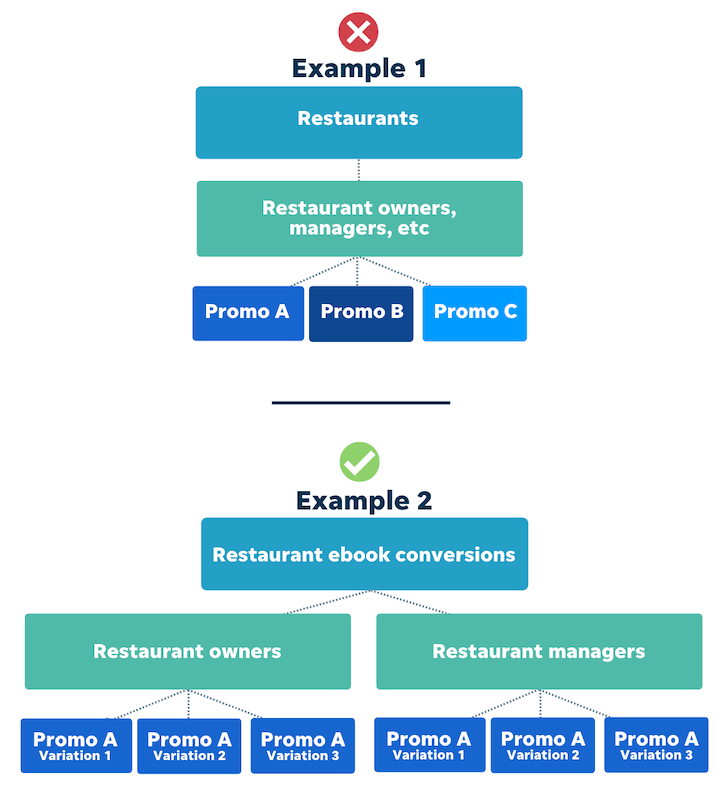
The reason why I typically stay away from example one is that centralizing the campaign around audiences can make the account messy as you introduce more ad sets and promotions. By instead focusing the campaign on the goal or desired outcome, you can then consolidate multiple audiences within one.
2. They keep their audiences refined
This brings me to the other problem I have with Example #1—many folks will combine multiple audiences into one ad set. Facebook encourages this consolidation as it makes for a bigger audience which gets you out of the learning period faster. However I like to take a more refined approach, particularly with smaller budgets. This allows me to have tighter control on optimizations which I will discuss further in the post.
3. They consolidate their conversion goals
It should be noted that I’m not dissuading testing multiple promotions against one another, but I’m suggesting that if you do, that you make sure there is a common conversion goal associated with each—for example, a common custom conversion event parameter in the thank you page URL—so that you have one conversion for any current or new ebook conversion actions.
4. They make reporting easier for themselves
Ensuring there is an alignment between a campaign’s goal and the ad that it subsequently leads to is paramount. If you are running a campaign with the objective of driving website traffic, you can essentially swap ads in and out that lead to whichever pages you desire. But if your objective is to drive leads or specific actions, there is inherently going to be more complexity. This is one of the primary reasons why I choose to structure accounts in the manner that I explained above. A direct line from campaign to conversion goal is the easiest way to make sure everything is easy to read and report on.

Since the iOS 14 update, there is a maximum of eight conversion actions that can be used in your campaigns (Aggregated Event Measurement). It’s very important to track conversions in a way that is simplified and efficient. This goes back to my point above about how having a common parameter for “like” actions can make a world of a difference.
Let’s say, for example, that you have two ebooks whose destination pages are very different. In order to launch both ads individually, you will have to create two separate custom conversions, and if you were to run both in a campaign together you will eventually be left with this:

No way to see conversion count in glance.
It may not seem like a big deal on the surface but you can save a lot of time by being able to see how many conversions have taken place at the campaign-level view. Otherwise, you are going to have to dig into each ad set and get to the ad level to see how many of each there are. When everything is cleanly organized and planned out you can make account-wide decisions much faster.
5. They choose daily budgeting on the ad set level
There are a few ways in which you can manage budget for Facebook campaigns:
- Daily budget, ad set level: within each campaign you can control how much you want to spend on each ad set/audience per day
- Daily budget, campaign level: allows for you to specify how much you would like your campaign to spend as a total per day. That means Facebook’s machine learning with allocate that total budget towards the ad sets that it believes will perform for the optimum cost.
- Scheduled/lifetime budgets: can be used if you have a scheduled duration for a campaign and want to ensure that the campaign meets that specific budget.
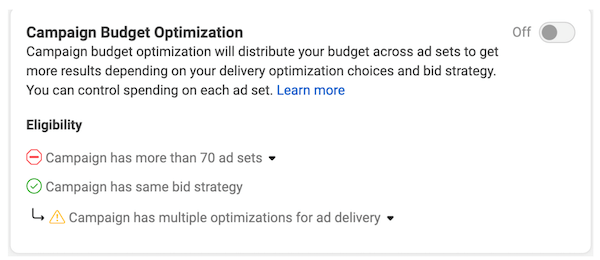
My preferred method in most cases is the daily budget on the ad set level. The primary reason for this is that for many of my clients there is a heavy emphasis on lead quality down-funnel.
A particular audience generating a high volume of leads doesn’t necessarily mean that those leads are of high quality. So when it comes to testing audiences and their respective quality I find it much easier to ensure my accounts are performing optimally for my clients by controlling the individual ad set spend.
For certain scenarios, campaign budget optimization is easier, however it is typically when the goal is higher in the marketing funnel.
6. They measure with the right metrics
Assuming that everything is cleanly organized and tracking is working properly, optimization becomes a game of audiences and ads. Depending upon the goal, optimization can vary in a few ways and so should your way of measuring the outcomes.
Traffic/engagement→ Surface-level metrics
When you have a fairly broader goal for a campaign (like web traffic, engagement, etc.), then surface-level metrics play a central role in how you report performance. I refer to any of the standard metrics provided on the Facebook platform, like impressions, clicks, CPC, CTR, to be “surface-level.”
Some of the major metrics to observe over time to guide your optimizations should be the relationship between reach, impressions, and frequency. For example, if you notice that your reach has essentially been capped out and only impressions and frequency are increasing, this means that your audience could potentially be fatigued.
You would next want to look at click performance in terms of volume, cost, and CTR over the same period of time. This will indicate whether the audience is truly fatigued and you need to either pause the ad set or introduce new ads.
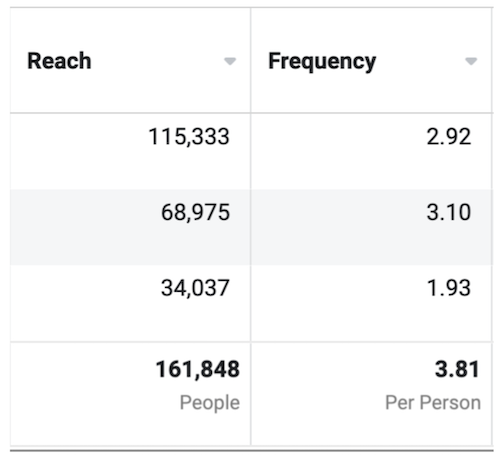
Lead gen → Leads and conversions
When your goal is lead generation, focusing on the number of conversions or leads over time would be the primary metric to judge the performance of the campaign or ad set.
If an ad set or ad has performed very well in the past but you have noticed the volume decrease and the cost per lead increase then you can subsequently look at the surface-level metrics to gauge whether or not the ad set or ad has run its course.
The beauty of the preferred account structure that I mentioned above is that once an ad set or ad becomes fatigued you can quickly introduce a new audience or ad very quickly without having to create an entirely new campaign.
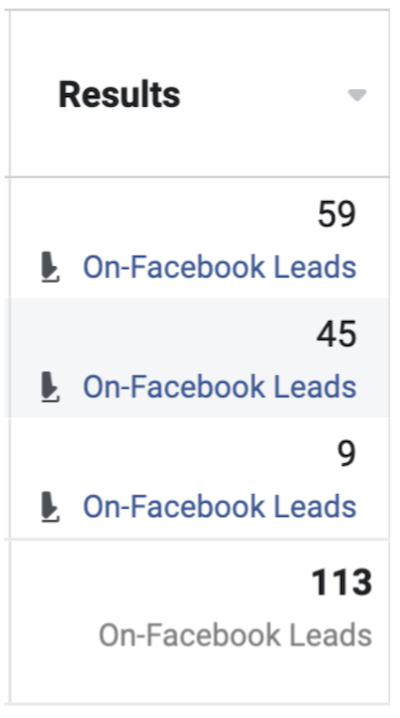
Lead quality → Website metrics
This is the next layer of Facebook ad optimization where you essentially tie the performance that you see on your website’s end to the performance within the account. With my preferred account structure, it should be relatively easy to understand which leads are coming from which audiences and you can therefore begin to make decisions within the account that are most aligned with the success of your business.
7. They don’t over-audit
What I refer to as an “audit” simply means looking at the account as a whole and making optimizations or changes to how things are structured. Many marketers wonder how frequently they should do Facebook ads audits. From a very general point of view, “If it ain’t broke don’t fix it” rings true.
If you are seeing success from your Facebook ads account, the best advice is to let things be and not intervene until you need to. This is why I place such heavy emphasis on account structure and proper tracking because if you have those elements taken care of, you automatically put yourself in a better position for long-term success. Making individual campaign, ad set, and ad changes and optiimzations becomes much easier, as does diagnosing where there are problem areas in the account.
Some folks may tell you when X ad reaches Y frequency then it is fatigued and you should turn it off. However, that rarely represents the full picture and many times I have seen ads with high frequencies continue to perform at a reasonable cost.
My point is, there are rarely cookie-cutter scenarios for how often you should make optimizations. Every business and ad account is different and understanding the nuances of each will allow you to get better at making those decisions when you need to.

Adopt these habits and improve your Facebook ad performance
Facebook ads can be a complex endeavor when viewed through the lens of all of the options and decisions at your disposal. The reality is, however, that the platform is as simple as you make it.
When you have a clear objective and method to approach that goal strategically and in an organized manner, everything else falls into place. The biggest issue most folks have is not covering the basics and jumping into spending their budget too quickly. Those are the folks who will tell you that it doesn’t work.
To recap, here are the seven Facebook advertising tips mentioned in this post:
They are:
- Organize campaigns by objective, not audience
- Keep your audiences refined
- Consolidate your conversion goals
- Make reporting easier for yourself
- Choose daily budgeting on the ad set level
- Measure with the right metrics
- Don’t over-audit
The post 7 Habits of Highly Effective Facebook Advertisers appeared first on WordStream.




Recent Comments